What’s Up?
Let’s dive into our very first Astronomy column!
Our awesome astronomer, Shishir Dholakia, is going to show us around the night sky and unveil its mysteries!
What’s Inside This Issue?
- Concepts and Terminology: Discover concepts and terminology introduced in the featured article.
- Featured Article: Join a real astronomer explaining why he loves his job, and why stargazing is important to you, too.
- About the Author: Meet our astronomer.
- Hands-On Activities: Engage in fun activities tailored to quickly raise your interest in the night sky and our place in it.
- Equity and Sustainability through Astronomy: Examine how doing some astronomy can contribute to advancing equity and sustainability.
- Glossary: Recap key concepts and terminology from the featured article.
Concepts and Terminology
| Terminology | Definition and Image Source | Image |
| Black Holes | Imagine a cosmic vacuum cleaner so strong that not even light can escape its pull. That’s why it’s called a black hole! They’re super mysterious and have gravity so intense it’s mind-blowing. Image Source: https://science.nasa.gov/resource/first-image-of-a-black-hole/ |  |
| Dark Matter | This mysterious stuff makes up most of the matter in the Universe but we can’t see it directly! It’s like invisible scaffolding holding galaxies together. Image Source: https://spaceplace.nasa.gov/dark-matter/en/ | 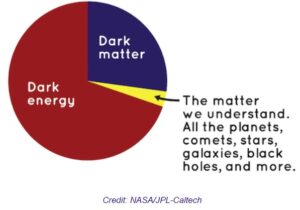 |
| Nebulae: | Glowing clouds of gas and dust in space like cosmic nurseries where new stars are born. They come in all sorts of shapes and colors some even resembling bubbles or glowing ghosts. The Great Carina Nebula Image Credit & Copyright: Demison Lopes https://apod.nasa.gov/apod/ap240419.html | 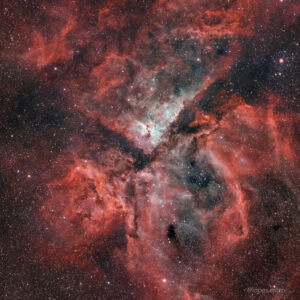 |
| Neutron Stars | When a massive star dies, it can crush itself into a super-dense ball mostly made of neutrons (tiny building blocks of atoms). That’s an artist’s image of a neutron star super strong and spinning really fast. Image Source: https://www.iac.es/en/outreach/news/outburst-neutron-star-reveals-nature-phenomena-only-observed-black-holes |  |
Featured Article
What’s Up?
by Shashir Dholakia
If you’ve ever looked up on a clear, dark night and wondered, “What’s up?” then you’ve had a taste of astronomy, the study of the universe we live in. This question is the launching pad for an exhilarating journey through the cosmos. The night sky tells a story – our home is a tiny blue marble flying through an unimaginably vast expanse filled with curiosities. Astronomers use the tools of science to learn about some of humanity’s deepest questions: Are we alone in the universe? What is the nature of reality? How did the universe begin, and what will be its fate?
Photo credit: Shishir Dholakia.
An astronomer’s job is to gather intelligence on the universe using only one clue: light. A tiny blip of light zips into our telescope from some distant planet, star, or galaxy. By ‘light,’ we mean every color (wavelength) of the electromagnetic spectrum that we can gather, from the shortest gamma rays (less than a billionth of a meter) to the longest radio waves (10’s of meters), and light visible to our eyes in between. Then, like detectives, astronomers use every tool in the shed and every trick in the book to figure out everything about that cosmic object. This is the central challenge of astronomy. No one can mess around with black holes or neutron stars in laboratories, so astronomers have to crack the case without even being at the scene of the crime. What is the nature of reality? How did the universe begin, and what will be its fate?
Astronomers have uncovered a staggering amount of information about the universe. We know that the Earth is just one of eight planets orbiting a massive, fiery ball of gas that is our Sun. The Sun isn’t alone – almost every speck in the night sky is another star like our Sun. Most of these stars have planets, too (we call them exoplanets). In fact, there are about a hundred billion stars in our galaxy. Staggeringly, our galaxy itself is one of billions or trillions of galaxies in the universe, all teeming with stars and planets. We know that the universe hasn’t always existed, too – it’s about 13 billion years old. It’s hard to grasp how vast the universe is, and there are parts of the universe almost too extreme for us to comprehend.
For example, black holes can pack unimaginable amounts of matter into a tiny void from which not even light can escape. If the Earth were compacted into a black hole, it would be about this big (smaller than a U.S. penny!) and contain everything you’ve ever known:
In the Press
Every time we unlock a mystery of the universe, another puzzle is waiting on the horizon. Astronomers are still hunting for many answers to questions we only now know to ask, from Earth-like planets to fast radio bursts, dark matter to the fate of the universe. We’ll explore many of these from the latest findings in astrophysics in this column.
Celestial Spotlight:
One of the easiest and most rewarding ways to learn about astronomy is through stargazing! By observing the sky at night, you can learn about the objects you see and deepen your understanding of the universe.
The stars always stay in place relative to each other, which is why ancient civilizations connected the dots, imagining patterns that we now call the constellations. The fixed backdrop of the stars rises and sets like the Sun. The planets and the moon, on the other hand, move across the backdrop of the sky from night to night. Over months, as the Earth points to a different direction of the sky through the seasons, the constellations visible in the night sky change too.
However, there are some constellations that remain permanently under the horizon, unless you can travel to the Southern Hemisphere of the Earth. One of the coolest ones is the Southern Cross (Crux). You might’ve heard of it being compared to our Northern Hemisphere’s North Star (Polaris).
About the Author
Hello! My name is Shishir, and I am excited to share the wonders of the universe with you in the section “What’s up.” I first met Paul at the Santa Clara county Science Fair when I was in middle school, where we bonded over our shared love of science and technology. I completed my bachelor’s degree in Astrophysics at the University of California, Berkeley, where I even took a class with Paul! I am now a PhD researcher at the University of Southern Queensland in Australia trying to learn more about exoplanets – planets around stars other than our Sun. Although my job has now advanced beyond stargazing, I’m still passionate about going out on a dark night and looking up at the beautiful night sky. Often, I’ll bring a telescope and a camera to enjoy even better views and take photographs of distant nebulae and galaxies. I’m pretty familiar with all the stars in the Northern Hemisphere now, even the ones at 5 AM. When I got here it was a little eerie, because I couldn’t even recognize half the sky, and the side that I could recognize was upside down. It’s very strange to see Orion and even the moon upside down. In my free time, I also enjoy playing badminton and taking photographs of nature.
Hands-on Activities
By observing the sky through all the seasons, you can learn to identify the stars and planets. To do this, you’ll need a star chart. You can access one of these handy tools on your phone or tablet. Some popular apps include Star Walk 2, Stellarium, NightSky 11, and SkySafari.
Once you’ve got the app going, hold your device up to the sky. You can then match up the stars you see with what’s on your screen. It’s a neat trick for spotting planets, important stars, constellation names, and even rare visitors like comets.
And if you can’t access one of these apps, good old paper and plastic charts work great, too! You can access the latest star maps at Skymaps – download and print the Northern Edition for the month, and ask a teacher if you need help using it. Enjoy exploring the cosmos, and happy stargazing!
Let’s go stargazing!
Dive right in by downloading one of the stargazing apps recommended by Shishir, or use a paper or plastic one. We’re using the Stellarium app on a basic Android phone (no fancy equipment needed) to show you the ropes.
In the three sets of photos shown here, the photo on the left in each set was taken out the window or outside on the street.
The photo on the right in each set is a screenshot of Stellarium in progress. Here’s a key tip: keep your phone steady when switching between the camera and the app – otherwise, key features won’t align!
All observations were done in San Jose, California in early April 2024. Let’s see how the two methods of observation compare…
Looking out west through a window after sunset, we see our Moon and the planet Jupiter and they are striking. We’ve added red arrows to match up some key objects. One advantage of using the app is that it showed us that we were also looking at the constellation Taurus, the bull! We didn’t know that!
Now having gone outside, we turned a little to our left (more towards the southwest) and could see the familiar figure of Orion, the hunter. Another advantage of the application is that it starts to teach us the names of well-publicized stars, like the red super-giant star Betelgeuse (sounds like the movie “Beetlejuice”).
Our last comparison: pointing more to the north and aiming up a little higher above horizon, we see the Big Dipper. The app reminds us that this constellation is also known as Ursa Major (the “Big Bear”). Once again, we can see the names of the key stars as we match them up one by one with our real vision.
Seeing how the application shown above uses sensors in your phone to determine your position and the tilt of the phone (angular position), along with a database of information, can you go back to our Newsletter #1 on Spatial Computing and compare and contrast this app and procedure to what we’ve described in that first issue?
Equity and Sustainability through Astronomy
Astronomy and Environmental Sustainability:
Gazing at the vast expanse of stars has filled humanity with wonder for millennia. This sense of awe can inspire us to protect our own fragile blue marble. The same curiosity that compels us to explore the cosmos can be harnessed to find solutions to the environmental challenges we face right here at home. By understanding Earth’s place in the universe, we can develop a deeper appreciation for its unique ability to sustain life. In essence, protecting our environment becomes a way to safeguard this precious oasis in the vast cosmos.
Astronomy plays a key role in protecting our planet! Satellites orbiting Earth, built with astronomical knowledge, aiming telescopes with sensors back at our Earth, track crucial environmental changes like rising sea levels and shrinking ice caps. This information empowers us to understand the impact of our actions and develop solutions for a sustainable future. By studying the universe, we gain the insights we need to protect our own planet.
Photo Credit: Nasa: Blue Marble 2002
Opening up the universe to all!
Astronomy can achieve the goals of inclusion, diversity, and opening up the universe to all in several exciting ways:
- Community outreach programs: Organizations like Astronomers Without Borders and AstroCamp bring astronomy education and stargazing experiences directly to underserved communities.
- Online resources and citizen science projects: Websites like Zooniverse offer free, online astronomy projects where anyone can contribute to real scientific research, regardless of location or background.
- Mentorship programs: Connecting young students with professional astronomers from diverse backgrounds can provide crucial guidance and inspiration. Organizations like the National Society of Black Physicists and the American Astronomical Society’s Committee on the Status of Minorities in Astronomy facilitate such connections.
- Scholarship opportunities: Scholarships specifically for underrepresented groups in astronomy can help break down financial barriers and open doors to higher education in the field. The AAS, for example, offers the Annie Jump Cannon Award for outstanding research by an undergraduate woman in astronomy.
These initiatives help create a more inclusive environment in astronomy, fostering a wider range of voices and perspectives in the pursuit of cosmic knowledge.
Glossary
| Terminology | Definition and Image Source | Image |
| Astronomy | Basically, it’s detective work of the Universe. Astronomers use telescopes (giant space-eyes) to study light and other clues to understand what’s out there. Image Source: Generated by Ideogram |  |
| Black Holes | Imagine a cosmic vacuum cleaner so strong that not even light can escape its pull. That’s why it’s called a black hole! They’re super mysterious and have gravity so intense it’s mind-blowing. Image Source: https://science.nasa.gov/resource/first-image-of-a-black-hole/ |  |
| Constellations | Patterns we see by connecting stars in the night sky. They’re like pictures in the sky like the Big Dipper or Orion the Hunter. Fun fact: the stars in these patterns aren’t actually close together in space! Some are nearer and some further away. Image Source: https://starwalk.space/en/news/zodiac-constellations | 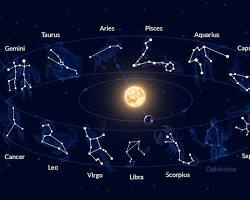 |
| Dark Matter | This mysterious stuff makes up most of the matter in the Universe but we can’t see it directly! It’s like invisible scaffolding holding galaxies together. Image Source: https://spaceplace.nasa.gov/dark-matter/en/ |  |
| Exoplanets | Planets that orbit stars outside our solar system. With new telescopes on satellites, we’re finding thousands of these alien worlds. Some which might even be habitable! Image Source: https://www.gps.caltech.edu/gps-research/research-programs/planetary-research-option/research-areas/exoplanets-planetary-astronomy |  |
| Galaxies | Giant collections of billions of stars dust and gas all swirling together. Our home the Milky Way is a spiral galaxy shaped like a giant pinwheel. Image Source: https://science.nasa.gov/universe/galaxies/ | 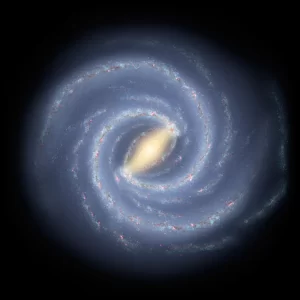 |
| Gamma Rays | The ultimate cosmic power punch! These are the most energetic type of light like tiny bullets zipping through space. They come from super-hot objects like exploding stars. Image Source: https://en.wikipedia.org/wiki/Gamma_ray | 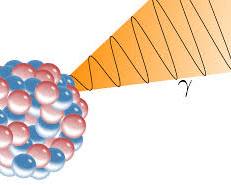 |
| Light | Light is like a messenger carrying information from distant objects. It travels super fast (almost unimaginable speeds!) and comes in different colors we can’t always see like radio waves and X-rays. Image Source: https://science.nasa.gov/mission/hubble/science/science-behind-the-discoveries/wavelengths/ | 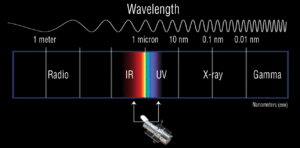 |
| Nebulae: | Glowing clouds of gas and dust in space like cosmic nurseries where new stars are born. They come in all sorts of shapes and colors some even resembling bubbles or glowing ghosts. The Great Carina Nebula Image Credit & Copyright: Demison Lopes https://apod.nasa.gov/apod/ap240419.html |  |
| Neutron Stars | When a massive star dies, it can crush itself into a super-dense ball mostly made of neutrons (tiny building blocks of atoms). That’s an artist’s image of a neutron star super strong and spinning really fast. Image Source: https://www.iac.es/en/outreach/news/outburst-neutron-star-reveals-nature-phenomena-only-observed-black-holes |  |
| Planets | Rocky or gassy worlds that orbit stars. Think of them as cosmic bowling balls whizzing around their stellar suns. Our solar system has eight planets including Earth! Image Source: https://spaceplace.nasa.gov/gallery-solar-system/en/ | 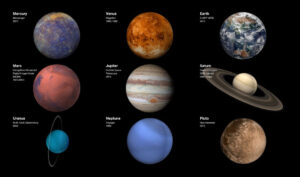 |
| Radio Waves | These are a type of light with really long wavelengths that our eyes can’t see. But special metal telescopes can pick them up revealing hidden objects in space. Image Source: https://www.britannica.com/science/radio-wave |  |
| Stars | Giant balls of burning gas like giant furnaces in space. They create light and heat using the same power source that might one day light up our cities through a process called nuclear fusion! Image Source: https://www.britannica.com/science/star-astronomy | 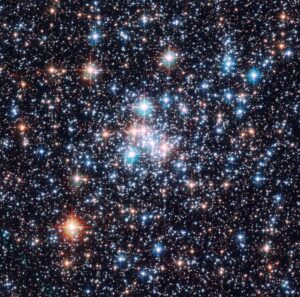 |
| Universe/ Cosmos | Everything that exists! It’s like the ultimate giant room containing everything from the tiniest atom to the biggest galaxies. Image Source: By NASA and the European Space Agency. – http://hubblesite.org/newscenter/archive/releases/2004/07/image/a/warn/, Public Domain, https://commons.wikimedia.org/w/index.php?curid=1499793 | 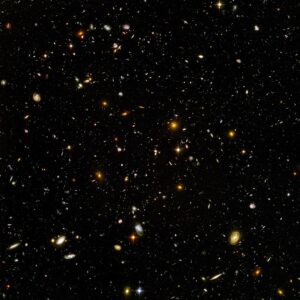 |
We value your input! Have questions about this issue or want to know more about our foundation?
Feel free to reach out. We’re keen to hear your thoughts and feedback. Your voice truly matters to us!
We hope you have enjoyed this issue of our newsletter.
We look forward to preparing our next issue on a different topic.
Subscribe to the Newsletter!
